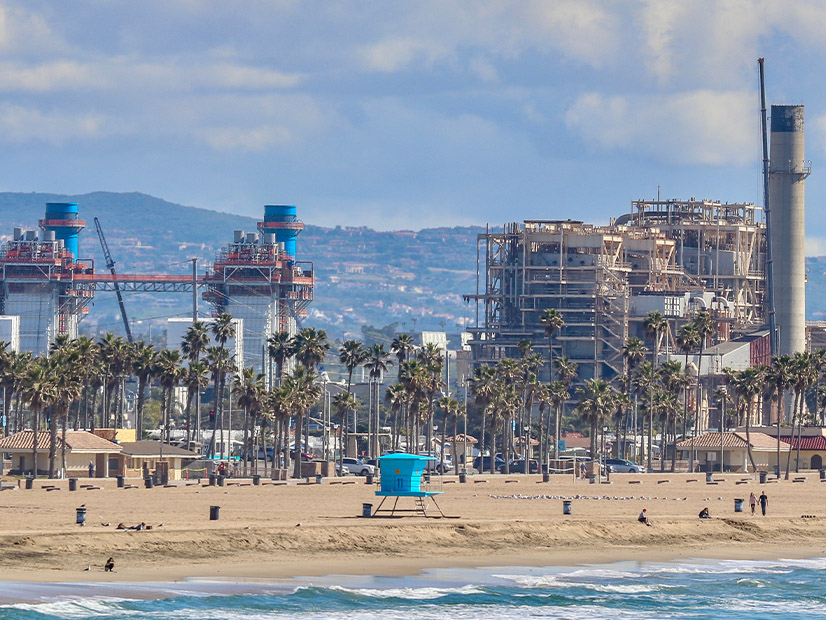The California Energy Commission agreed Wednesday to keep three old, environmentally damaging gas-fired plants operating along the Southern California coast for grid reliability, despite an outpouring of opposition from local residents and environmental groups.
It was the second three-year extension given to the once-through cooling plants, which had been scheduled to retire because of their harm to marine life and polluting of oceanside neighborhoods. But the state has deemed them necessary as it struggles to keep the lights on during heat waves while transitioning to 100% clean energy by 2045.
Energy Commission Chair David Hochschild called keeping the OTC plants operating a “collective failure,” even as he and his fellow commissioners voted to approve capacity agreements between the state Department of Water Resources (DWR) and the plants in Long Beach, Oxnard and Huntington Beach, Calif.
“I look forward to the day not just when these three facilities are retired, but when all fossil fuel generation is retired,” Hochschild said. “We have to build that future, and I believe we can. What’s aggravating for me is that we’re doing it, but we’re late.”
The vote followed more than two hours of impassioned testimony from those who live near the plants, saying they and their family members had been sickened by emissions and wanted the plants closed down, as planned, this year.
“What I hear here is this is a crisis of betrayal, a feeling of absolute trauma that communities feel over and over,” CEC Vice Chair Siva Gunda said in response to the residents’ pleas. Gunda said he found the decision difficult but was bound by the state’s need to avoid blackouts.
An extreme heat wave led to rolling blackouts in California in August 2020, followed by energy emergencies caused by heat waves and wildfires in the next two summers.
The commission’s decision approved DWR’s plan to spend up to $1.2 billion to maintain selected units at the Alamitos Generating Station in Long Beach, the Huntington Beach Generating Station in Orange County and the Ormond Beach Generating Station in Oxnard for three more years, until Dec. 31, 2026.
The once-through cooling plants, which had originally been set to retire in 2020, had already gotten a reprieve until 2023 for the sake of reliability.
AES Corp., based in Arlington, Va., owns the Alamitos and Huntington Beach plants, while Houston-based GenOn owns the Ormond Beach facility. Collectively, the units to be kept online can generate nearly 2,900 MW of capacity.
DWR will issue the companies fixed monthly capacity payments of $8.82/kW-month to $10.95/kW-month, for a three-year total of as much as $1.19 billion. The department runs the state’s Electricity Supply and Strategic Reliability Reserve Program, which acts as a backstop to provide incremental power during extreme events.
Legislation passed hastily in June 2022 assigned the role to DWR and approved Gov. Gavin Newsom’s proposed $5.2 billion strategic reliability reserve consisting of “existing generation capacity that was scheduled to retire, new generation, new storage projects, clean backup generation projects, [and] diesel and natural gas backup generation projects.” (See California to Pass Sweeping Energy Policy Changes.)
Critics lamented the bill in large part because the once-through cooling plants would likely be retained as part of the reliability reserve.
The plants, built in the 1950s and 1960s, use ocean water for cooling, killing billions of marine organisms. In 2010, the State Water Resources Control Board ordered the phase-out of 19 OTC plants along the coast.
Some plants retired, and others updated to air-cooling or alternative water-cooling technologies. The last three plants — Alamitos, Huntington Beach and Ormond Beach — still use their original cooling designs.
The hulking plants loom over densely populated coastal communities, wetlands and sandy beaches. Many residents and elected officials have wanted them closed for years because they are noisy, unsightly and polluting, but California’s energy shortfalls have extended their lifespans.
The State Water Resources Control Board must still sign off on the DWR to keep the OTC plants online. It has scheduled a hearing for Aug. 15 to consider the extension, which it is expected to approve.

